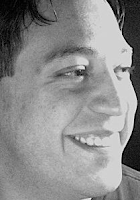How hard can gaining an audience for your book really be? Surely, the biggest battle is getting it signed by a publisher, right? Well, as a long-time blogger and newbie to the marketing and publicity side of publishing, I'm here to tell you that, as an author - whether you self published or were picked up by a small press - the hard work is only just beginning...
And Chris Dietzel, author of The Man Who Watched the World End, agrees with me. Heck, this former MMA cage fighter has a pretty cool analogy about fighting vs writing for you to sink your teeth and fists into.... Check it out:
Fighting and Writing
I’ve fought inside a cage, and I’ve written a novel. I’m here to tell you that winning in mixed martial arts (MMA) is easy compared to gaining an audience when you’re an unknown author.
After graduating college in 2000, I immediately started training in Brazilian Jiu Jitsu (BJJ) with the intent of fighting in sanctioned cage fights. I had always been a goofy kid, the class clown, but as soon as I saw tapes of MMA fights in college, I knew I needed to give it a shot. As someone who never took anything seriously, even the dreams I held most dear, the cage fights were a test of the most basic fight-or-flight variety, a challenge that would teach me what type of person I really was.
The goal became an obsession. I saw the people in my gym who trained more often and more ferociously than everyone else, and I wanted to train even harder than they did. Along the way, the confidence that BJJ gave me in myself, changing me from the court jester to someone who understood the importance of goals and personal victories, allowed me to think about my other dream, even more secretive and dear to me than fighting, as something other than a fool-hardy delusion. I wanted to write the Great American novel.
In college, I had so little confidence in achieving my goals that I didn’t even bother taking a creative writing class. But only a few years later, thanks to BJJ, I began to think of this fantasy as something I could achieve if I truly dedicated myself to it. It was still a secret from my friends and family, something they might think of as an unrealistic pipedream. But to me it was no longer a foolish goal to be laughed away.
Starting in 2004, when I wasn’t working at my 9-5 job or training in BJJ or MMA, I was writing. Instead of going out with friends on Friday and Saturday nights, I wrote. Instead of going to Happy Hour, I went home and wrote. I had two goals: fighting and writing. Absolutely all of my time was devoted toward these two ends.
In 2006, I earned my brown belt in BJJ and had my first MMA fight, which I won. A couple months later, I had my second fight and my record improved to 2-0. What I noticed was that both fights were easier than the training I went through in preparation for them. I practiced with the goal that if I trained harder, trained more often, and trained smarter than my opponent, I would win. The result was completely up to me. And that theory held up.
During this entire time, I was honing my craft as a writer, developing my voice, understanding my strengths and weaknesses, and generally improving my craft.
My original intent was to fight four times. That would give me a big enough taste of MMA to prove to myself that I had achieved my goal. Life has a way, though, of altering your plans. Right before my third fight, I suffered a series of injuries, culminating with a neck injury that would ultimately prevent me from ever fighting again. This was okay because it allowed me to focus my time on writing.
In the years since, every hour I have that’s not spent working at my day job is dedicated to achieving my dream of being a novelist. I come home from work and I write. When my friends go out on the weekends, I stay home and write. This is not meant to sound like a sacrifice; it’s what I enjoy and it comforts me to know I’m working toward a dream that I was once afraid to tell other people I even had.
Over the years, I’ve had a couple short stories published and I’ve been signed to a wonderful literary agency. Little did I know that the most difficult fight was still in front of me, the aspect of writing that makes it so much more challenging than evading kicks and elbows. Both adventures require determination if you want to have any hope of following through with your goal. Both require an endless willingness to learn from your mistakes. But when you fight, the outcome is completely in your own hands. If you have better technique and better conditioning than your opponent, chances are extremely likely that your hand will be raised after the final bell. But in writing, no matter how much you work toward your goal, no matter how focused you are, the result depends on other people. You can become a truly great writer. You can write powerful stories. But in the end, whether or not people want to read what you write is out of your hands. You depend on other people to see value in what you’ve written, and you depend on them to spread the word about it.
That’s the difference between fighting and writing that makes the latter so much more brutal than breaking another man’s spirit inside a cage. A fighter controls his destiny. A writer, no matter how hard he or she works toward their goal, needs good luck and good fortune and support from people all over. For a fighter, for someone who relishes that outcomes are based on tangible things such as hours spent in the gym, this is the most formidable type of battle.
Do not interpret this as pessimism sneaking into the cracks of a lifelong dream. Nothing will make me give up my goal of gaining an audience for my novels. If BJJ and MMA have taught me anything, it’s that even if you lose one day, you’re only defeated when you don’t get back in for the next fight. Then, and only then, are you truly beaten. I know it sounds corny, but it’s true. No, it’s not pessimism at all that makes me say how much more difficult writing is than fighting. It’s a personal reminder that the eventual victory will be even sweeter in the end. It’s meant to remind any other struggling writers out there that what you’re doing requires more tenacity than dodging punches and escaping chokes. You are only defeated when you stop putting words to paper. To quote the writer J.A. Konrath, “There’s a word for writers who never say die… the word is published.” I will keep up the fight. If writing is your dream, you should keep going too.
And along the way, the next time you read something that you enjoy, no matter what it is, pass it along to someone else who may enjoy it. And when you do, know that you are helping its author do something even more demanding than beating a trained fighter—you are helping them achieve their dream.
Chris graduated from Western Maryland College (McDaniel College). He currently lives outside Washington D.C. His dream is to write the same kind of stories that have inspired him over the years. His short stories have appeared in Temenos, Foliate Oak, and Down in the Dirt. THE MAN WHO WATCHED THE WORLD END is his first novel.







.jpg)





































